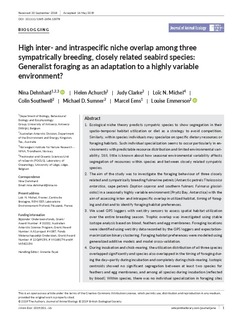High inter‐ and intraspecific niche overlap among three sympatrically breeding, closely related seabird species: Generalist foraging as an adaptation to a highly variable environment?
Denhard, Nina; Achurch, Helen; Clarke, Judy; Michel, Loïc N.; Southwell, Colin; Sumner, Michael D.; Eens, Marcel; Emmerson, Louise
Peer reviewed, Journal article
Published version

Åpne
Permanent lenke
http://hdl.handle.net/11250/2616978Utgivelsesdato
2019Metadata
Vis full innførselSamlinger
- Scientific publications [1392]
Originalversjon
10.1111/1365-2656.13078Sammendrag
1. Ecological niche theory predicts sympatric species to show segregation in their
spatio‐temporal habitat utilization or diet as a strategy to avoid competition.
Similarly, within species individuals may specialize on specific dietary resources or
foraging habitats. Such individual specialization seems to occur particularly in environments
with predictable resource distribution and limited environmental variability.
Still, little is known about how seasonal environmental variability affects
segregation of resources within species and between closely related sympatric
species.
2. The aim of the study was to investigate the foraging behaviour of three closely
related and sympatrically breeding fulmarine petrels (Antarctic petrels Thalassoica
antarctica, cape petrels Daption capense and southern fulmars Fulmarus glacialoides)
in a seasonally highly variable environment (Prydz Bay, Antarctica) with the
aim of assessing inter‐ and intraspecific overlap in utilized habitat, timing of foraging
and diet and to identify foraging habitat preferences.
3. We used GPS loggers with wet/dry sensors to assess spatial habitat utilization
over the entire breeding season. Trophic overlap was investigated using stable
isotope analysis based on blood, feathers and egg membranes. Foraging locations
were identified using wet/dry data recorded by the GPS loggers and expectationmaximization
binary clustering. Foraging habitat preferences were modelled using
generalized additive models and model cross‐validation.
4. During incubation and chick‐rearing, the utilization distribution of all three species
overlapped significantly and species also overlapped in the timing of foraging during
the day—partly during incubation and completely during chick‐rearing. Isotopic
centroids showed no significant segregation between at least two species for
feathers and egg membranes, and among all species during incubation (reflected
by blood). Within species, there was no individual specialization in foraging sites
or environmental space. Furthermore, no single environmental covariate predicted
foraging activity along trip trajectories. Instead, best‐explanatory environmental
covariates varied within and between individuals even across short temporal
scales, reflecting a highly generalist behaviour of birds.
5. Our results may be explained by optimal foraging theory. In the highly productive
but spatio‐temporally variable Antarctic environment, being a generalist may be
key to finding mobile prey—even though this increases the potential for competition
within and among sympatric species.
